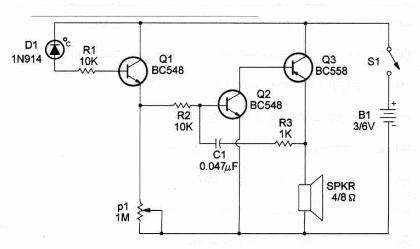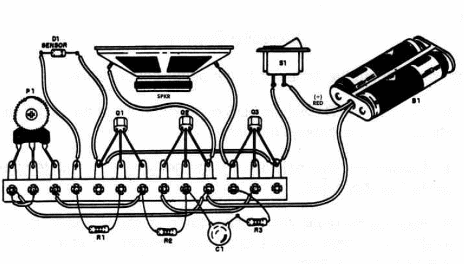You can conduct interesting experiments with this temperature-dependent oscillator.
Tone pitch depends upon the temperature of a sensor. The sensor is a common general-purpose silicon diode.
The reverse resistance of this diode is slight, dependent on the junction temperature.
The circuit can operate in a temperature range typically between -20 and +100 degrees Celsius.
Frequency range depends upon C1 .This component can be altered in a large range of values.
Values between 0.01 and 0.47 µF can be substituted to produce tones in the audio range.
If you want to produce “clicks” with a rate dependent upon the temperature of the sensor, try capacitors with values between 0.47 and 1 µF. Metal film or ceramic capacitors can be used in this circuit.
By adjusting P1 you can put the oscillator near the point where it begins to run.
Then, any temperature rise will trigger the oscillator, making it operate as a temperature alarm.
The circuit can be powered from two or four AA cells, and current drain is low.
The sensor is any general-purpose silicon diode. The diode can be protected against moisture and water.
The schematic diagram of the Temperature-Controlled Oscillator is shown in figure 1.

The sensor can be wired to the circuit by a long twisted-pair wire for remote operation.
Components layout, using a terminal strip as chassis, is shown in figure 2.

As the circuit is intended for experimental purposes, you can also mount it on a solderless board.
Position of polarized components, such as the diode and power supply, should be observed.
Temperature-Controlled Oscillator
Q1, 2 - BC548 general-purpose NPN silicon transistors
Q3 - BC558 general-purpose PNP silicon transistor
D1 - 1N914 general-purpose silicon diode
P1 - 1,000,000 ohm potentiometer
R1, 2 - 10,000 ohm, ¼ W, 5% resistors
R3 - 1,000 ohm, ¼ W, 5% resistor
C1 - 0.047 µF ceramic or metal film capacitor
S1 - SPST toggle or slide switch
B1 – 3 V or 6V - two or four AA cells
SPKR - 4 or 8 Ω - 2 or 4 in. loudspeaker
Ideas to Explore
To learn more about the circuit or to get better performance:
By replacing D1 with an LDR or phototransistor the circuit will operate as a light-controlled oscillator.
Explain why the resistance of the sensor varies with temperature, controlling this circuit.
Replace the diode with a transistor (conection is made using collector and emitter terminals). Explain why this device can also be used as a temperature sensor.
Science projects or uncommon uses:
You can use this circuit as a biofeedback device by replacing the sensor with two electrodes. The subject, holding the sensor in hand, can learn how to control the tone through stress and breathing management. The circuit also operates as a lie detector using this configuration.
Any experiment involving temperature variations can be conducted using this circuit.




